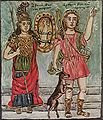Theophilos Hatzimihail

Theophilos Chatzimichail (Greek: Θεόφιλος Χατζημιχαήλ or Θεόφιλος Κεφαλάς; born c. 1870, Vareia, near Mytilene, island of Lesbos; died in Vareia, Greece, 24 March 1934), known simply as Theophilos, was a Greek folk painter and major contributor in modern Greek art. The main subject of his works are Greek characters and the illustration of Greek traditional folklore and history.[1]
Life and work
The exact birthdate of Theophilos is unknown. However, it is believed that he was born between 1867 and 1870 in Vareia (Βαρειά), a village outside of
His life was very hard, partially because people made fun of him since he often wore the fustanella in public. At the age of 18 he abandoned his home and family and worked as a gate-keeper (καβάσης, kavasis) at the Greek consulate in Smyrna.
He stayed in Smyrna for a few years before he settled in the city of
In 1927 he returned to Mytilene. Legend states that he left Volos because of an incident in a kafeneio (coffee shop) where someone played a joke on him in front of others and threw him down from a ladder where he was painting.
In Mytilene, despite the mockery of the people, he continued to draw, painting many murals in villages for little payment, usually for a plate of food and a cup of wine.[2] Many of his works of this period have been lost, either due to natural aging or from damage by the owners.
In Mytilene, the renowned art critic and publisher Stratis Eletheriadis (Tériade), who lived in Paris, discovered Theophilos and brought him a great deal of recognition and also international publicity, though posthumous.[1]
Theophilos died in March 1934, on the eve of the Annunciation, perhaps from food poisoning. In 1961, his works were exhibited in the Louvre as a sample of a genuine folk painter of Greece. In 1965, Tériade donated 86 painted works on textile to the Municipality of Lesvos, along with a building that became the Theophilos Museum in Vareia, Lesbos.
Gallery
-
Erotokritos and Arethousa
-
Athena and Artemis
-
Symposium of Empress Eudoxia
-
Constantine Palaiologos
-
Alexander the Great
-
Theseus
References
- ^ a b Lampraki-Plaka, Marina· Karakourti-Orfanopoulou, Lamprini, ed. (2020). Η ανθρώπινη μορφή στην ελληνική ζωγραφική, 20ός αιώνας. Athens: Ίδρυμα Βασίλη και Μαρίνας Θεοχαράκη. p. 23. ISBN 978-618-5201-10-4.
- ^ In the novella Vasilis Arvanitis, Stratis Myrivilis describes a coffee house near the Karini spring in Lesbos as famous because “its walls, inside and out, are covered with pictures and designs by the painter Theophilos.” Of Theophilos himself he writes: “He was a strange man and people thought him half crazy.” (Stratis Myrivilis, Vasilis Arvanitis, translated into English by Pavlos Andronikos [Armidale: University of New England Publishing Unit, 1983], pp. 51-2.)
Sources
- Yannis Tsarouchis, Theophilos (Athens: The Commercial Bank of Greece, 1966).
- ISBN 960-17-0011-0.
- ISBN 960-85703-1-X.
- Ε. Παπαζαχαρίου, Ο άλλος Θεόφιλος, εκδ. Κάκτος, Αθήνα 1997.
- Ντ. Παπασπύρου, Θεόφιλος Γ.Χ. Μιχαήλ, εκδ. Ιανός, Θεσσαλονίκη 1998. ISBN 960-7771-16-8.
External links
- Theophilos Museum - House of Giannis Kontos (Volos)
- Museum of Works by Theophilos(Mytilene Lesbos Island Greece)
- Biography and works
- The death of Theophilos (Ιστορία Εικονογραφημένη, August 2002)
- Article in news paper Ta Nea, 3 January 2000
- Odysseas Elytis on Theophilos
- Θεόφιλος at Cine.gr (archived) (in Greek)






